
KNOTS, SPLICES and ROPE WORK
| Larks' Heads. Slippery and Half-hitches. Clove Hitches. Gunners' Knots
and Timber Hitches. Twists, Catspaws, and Blackwall Hitches. Chain
Hitch. Rolling and Magnus Hitches. Studding-sail and Gaff-topsail
Halyard Bends. Roband and Fisherman's Hitches. |
TIES AND HITCHES
All the knots I have so far described are used mainly for fastening
the two ends of a rope, or of two ropes, together. Of quite a
different class are the knots used in making a rope fast to a
stationary or solid object, and are known as "hitches" or "ties."

One of the easiest of this class to make and one which is very useful
in fastening a boat or other object where it may be necessary to
release it quickly is the "Lark's Head" (Fig. 30). To make this tie,
pass a bight of your rope through the ring, or other object, to which
you are making fast and then pass a marline-spike, a billet of wood,
or any similar object through the sides of the bight and under or
behind the standing part, as shown in A, Fig. 30.

The end of the rope may then be laid over and under the standing part and back over
itself. This knot may be instantly released by merely pulling out the toggle.

Almost as quickly made and unfastened is the "Slippery Hitch"
(Fig. 32).

To make this, run the end of the rope through the ring or
eye to which it is being fastened, then back over the standing part
and pull a loop, or bight, back through the "cuckold's neck" thus
formed (Fig. 33). To untie, merely pull on the free end.
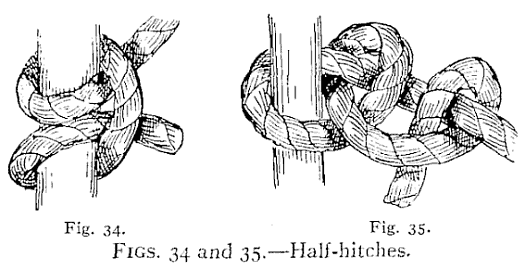
Two half-hitches, either around a post or timber or around the standing
part of the rope, make an ideal and quickly tied fastening (Figs. 34
and 35). To make these, pass the end around the post, ring, or other
object, then over and around the standing part between the post and
itself, then under and around the standing part and between its own
loop and the first one formed. After a little practice you can tie
this knot almost instantly and by merely throwing a couple of turns
around a post, two half-hitches may be formed instantly. This knot
will hold forever without loosening, and even on a smooth, round stick
or spar it will stand an enormous strain without slipping.
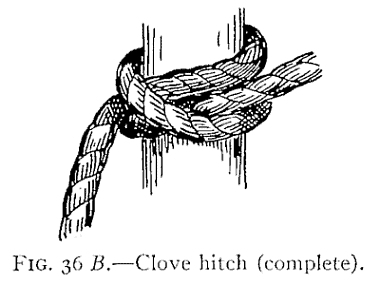
A more secure knot for this same purpose is the "Clove Hitch" (Fig. 36),
sometimes known as the "Builders' Hitch."
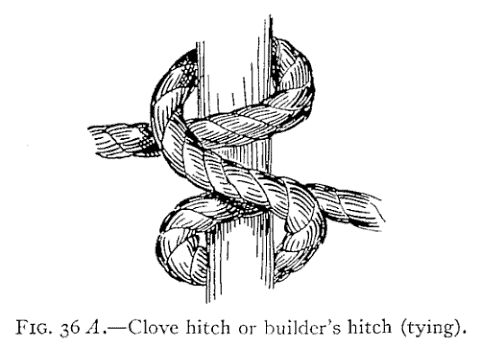
To make this, pass the end of rope around the spar or timber, then over itself;
over and around the spar, and pass the end under itself and between rope and spar,
as shown in the illustration.

The Clove hitch with ends knotted becomes
the "Gunners' Knot" (Fig. 37). These are among the most valuable and
important of knots and are useful in a thousand and one places. The
Clove hitch will hold fast on a smooth timber and is used extensively
by builders for fastening the stageing to the upright posts. It is
also useful in making a tow-line fast to a wet spar, or timber, and
even on a slimy and slippery spile it will seldom slip.

For this purpose the "Timber Hitch" (Fig. 38) is even better than
the Clove hitch. It is easily made by passing the end of a rope around the spar
or log, round the standing part of the rope and then twist it three or
more times around, under and over itself.

If you wish this still more secure, a single half-hitch may be taken with the line
a couple of feet further along the spar (Fig. 39).
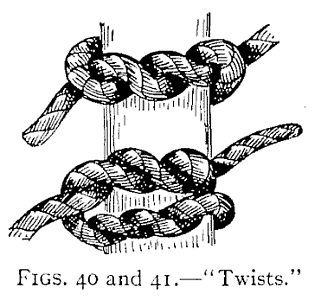
It is remarkable what power to grip a twisted rope has, and the "Twist
Knots" shown in Figs. 40 and 41 illustrate two ways of making fast
which are really not knots at all but merely twists.

These may be finished by a simple knot, or a bow-knot, as shown in Fig. 42,
but they are likely to jam under great pressure and are mainly useful in
tying packages, or bundles, with small cord, where the line must be
held taut until the knot is completed.

This principle of fastening by
twisted rope is also utilized in the "Catspaw" (Fig. 43), a most
useful knot or "hitch" for hoisting with a hook.

To make this, pass the bight of your rope over the end and standing part, then,
with a bight in each hand, take three twists from you, then bring the two
bights side by side and throw over the hook (Fig. 44).

The "Blackwall Hitch" (Fig. 45) is still simpler and easier to make
and merely consists of a loop, or cuckold's neck, with the end of rope
passed underneath the standing part and across the hook so that as
soon as pressure is exerted the standing part bears on the end and
jams it against the hook.

The "Chain Hitch" (Fig. 46) is a very strong method of fastening a
line to a timber, or large rope, where one has a rope of sufficient
length, and is used frequently to help haul in a large rope or for
similar purposes.

It consists simply of a number of half-hitches taken
at intervals around the object and is sometimes used with a lever or
handspike, as shown in Fig. 47.

The "Rolling Hitch" is a modified Clove hitch and is shown in Fig. 48.

The "Magnus Hitch" (Fig. 49) is a
method frequently used on shipboard for holding spars;

and the
"Studding-sail Bend" (Fig. 50) is also used for this purpose.
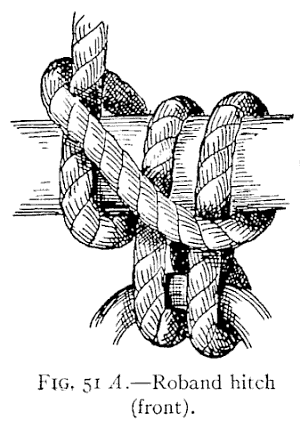
Occasions sometimes arise where a tackle, hook, ring, or another rope
must be fastened to a beam by the same rope being used, and in such
cases the "Roband Hitch" (Fig. 51) comes in very handy.
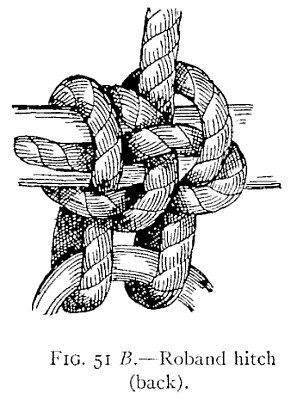
These are all so simple and easily understood from the figures that
no explanation is necessary.

Almost as simple are the "Midshipman's Hitch" (Fig. 52),
the "Fisherman's Hitch" (Fig. 53), and the "Gaff Topsail Halyard
Bend" (Fig. 54). The midshipman's hitch is made by taking a half-hitch
around the standing part and a round turn twice around above it.

The fisherman's hitch is particularly useful in making fast large hawsers;
with the end of a rope take two turns around a spar, or through a
ring; take a half-hitch around the standing part and under all the
turns; then a half-hitch round the standing part only and if desired
seize the end to standing part.

The gaff-topsail bend is formed by
passing two turns around the yard and coming up on a third turn over
both the first two turns; over its own part and one turn; then stick
the end under the first turn.

























